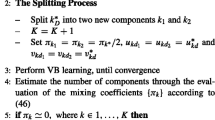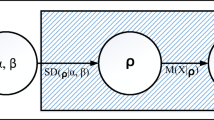Abstract
In this paper, we present a mixture density based approach to invariant image object recognition. To allow for a reliable estimation of the mixture parameters, the dimensionality of the feature space is optionally reduced by applying a robust variant of linear discriminant analysis. Invariance to affine transformations is achieved by incorporating invariant distance measures such as tangent distance. We propose an approach to estimating covariance matrices with respect to image variabilities as well as a new approach to combined classification, called the virtual test sample method. Application of the proposed classifier to the well known US Postal Service handwritten digits recognition task (USPS) yields an excellent error rate of 2.2%. We also propose a simple, but effective approach to compensate for local image transformations, which significantly increases the performance of tangent distance on a database of 1,617 medical radiographs taken from clinical daily routine.
Similar content being viewed by others
References
J. Dahmen, K. Beulen, M. Güld, and H. Ney, “A mixture density based approach to object recognition for image retrieval,” in Proc. 6th Int. RIAO Conf. on Content-Based Multimedia Information Access, Paris, France, 2000, pp. 1632–1647.
J. Dahmen, D. Keysers, M. Güld, and H. Ney, “Invariant image object recognition using Gaussian mixture densities,” in Proc. 15th Int. Conf. on Pattern Recognition, Barcelona, Spain, 2000, pp. 614–617.
J. Dahmen, T. Theiner, D. Keysers, H. Ney, T. Lehmann, and B. Wein, “Classification of radiographs in the ‘Image Retrieval in Medical Applications’ system (IRMA),” in Proc. 6th Int. RIAO Conf. on Content-Based Multimedia Information Access, Paris, France, 2000, pp. 551–566.
J. Dahmen, D. Keysers, M. Pitz, and H. Ney, “Structured covariance matrices for statistical image object recognition,” in Proc. 22nd Symposium German Association for Pattern Recognition, Kiel, Germany, 2000, pp. 99–106.
J. Dahmen, R. Schlüter, and H. Ney, “Discriminative training of Gaussian mixtures for image object recognition,” in Proc. 21st Symposium German Association for Pattern Recognition, Bonn, Germany, 1999, pp. 205–212.
J. Dahmen, J. Hektor, R. Perrey, and H. Ney, “Automatic classification of red blood cells using Gaussian mixture densities,” in Proc. Bildverarbeitung für die Medizin, Munich, Germany, 2000, pp. 331–335.
A. Dempster, N. Laird, and D. Rubin, “Maximum likelihood from incomplete data via the EM algorithm,” Journal Royal Statistical Society, Vol. 39(B), pp. 1–38, 1977.
P. Devijver and J. Kittler, Pattern Recognition. A Statistical Approach, Prentice-Hall: Englewood Cliffs, NJ, 1982.
H. Drucker, R. Schapire, and P. Simard, “Boosting performance in neural networks,” Int. Journal of Pattern Recognition and Artificial Intelligence, Vol. 7, No. 4, pp. 705–719, 1993.
R. Duda and P. Hart, Pattern Classification and Scene Analysis, John Wiley & Sons: New York, 1973.
Y. Freund and R. Schapire, “Experiments with a new boosting algorithm,” in Proc. 13th Int. Conf. on Machine Learning, Bari, Italy, 1996, pp. 148–156.
K. Fukunaga, Introduction to Statistical Pattern Recognition, Academic Press: San Diego, CA, 1990.
T. Hastie, P. Simard, and E. Säckinger, “Learning prototype models for tangent distance,” in Proc. Advances in Neural Information Processing Systems 7, MIT Press, Cambridge, MA, 1995, pp. 999–1006.
G. Hinton, M. Revow, and P. Dayan, “Recognizing handwritten digits using a mixture of linear models,” in Proc. Advances in Neural Information Processing Systems 7, MIT Press, Cambridge, MA, 1995, pp. 1015–1022.
D. Keysers, J. Dahmen, T. Theiner, and H. Ney, “Experiments with an extended tangent distance,” in Proc. 15th Int. Conf. on Pattern Recognition, Barcelona, Spain, 2000, pp. 38–42.
D. Keysers, J. Dahmen, and H. Ney, “A probabilistic view on tangent distance,” in Proc. 22nd Symposium German Association for Pattern Recognition, Kiel, Germany, 2000, pp. 107–114.
J. Kittler, M. Hatef, and R. Duin, “Combining classifiers,” in Proc. 13th Int. Conf. on Pattern Recognition, Vienna, Austria, 1996, pp. 897–901.
T. Lehmann, B. Wein, J. Dahmen, J. Bredno, F. Vogelsang, and M. Kohnen, “Content-based image retrieval in medical applications: A novel multi-step approach,” in Proc. Int. Society for Optical Engineering (SPIE), Vol. 3972, No. 32, 2000, pp. 312–320.
Y. Linde, A. Buzo, and R. Gray, “An algorithm for vector quantizer design,” IEEE Trans. Communications, Vol. 28, No. 1, pp. 84–95, 1980.
B. Moghaddam and A. Pentland, “Probabilistic visual learning for object representation,” IEEE Trans. Pattern Analysis and Machine Intelligence, Vol. 19, No. 7, pp. 696–710, July 1997.
H. Ney, “Acoustic modelling of phoneme units for continuous speech recognition,” Fifth European Signal Processing Conf., Barcelona, pp. 65–72, Sep., 1990.
W. Press, S. Teukolsky, W. Vetterling, and B. Flannery, Numerical Recipes in C, Cambridge University Press, New York, 1992.
B. Schiele and J. Crowley, “Probabilistic object recognition using multidimensional receptive field histograms,” in Proc. 13th Int. Conf. on Pattern Recognition, Vienna, Austria, 1996, pp. 50–54.
B. Schölkopf, P. Simard, A. Smola, and V. Vapnik, “Prior knowledge in support vector kernels,” in Proc. Advances in Neural Information Processing Systems 10, MIT Press, Cambridge, MA, 1998, pp. 640–646.
H. Schwenk and M. Milgram, “Transformation invariant autoassociation with application to handwritten character recognition,” in Proc. Advances in Neural Information Processing Systems 7, MIT Press, Cambridge, MA, 1995, pp. 991–998.
P. Simard, Y. Le Cun, and J. Denker, “Efficient pattern recognition using a new transformation distance,” in Proc. Advances in Neural Information Processing Systems 5, Morgan Kaufmann, San Mateo, CA, 1993, pp. 50–58.
P. Simard, Y. Le Cun, J. Denker, and B. Victorri, “Transformation invariance in pattern recognition—Tangent distance and tangent propagation,” Lecture Notes in Computer Science, Vol. 1524, Springer: New York, 1998, pp. 239–274.
V. Vapnik, The Nature of Statistical Learning Theory, Springer: New York, 1995.
J. Wood, “Invariant pattern recognition: A review,” Pattern Recognition, Vol. 29, No. 1, pp. 1–17, January 1996.
Author information
Authors and Affiliations
Rights and permissions
About this article
Cite this article
Dahmen, J., Keysers, D., Ney, H. et al. Statistical Image Object Recognition using Mixture Densities. Journal of Mathematical Imaging and Vision 14, 285–296 (2001). https://doi.org/10.1023/A:1011242314266
Issue Date:
DOI: https://doi.org/10.1023/A:1011242314266




